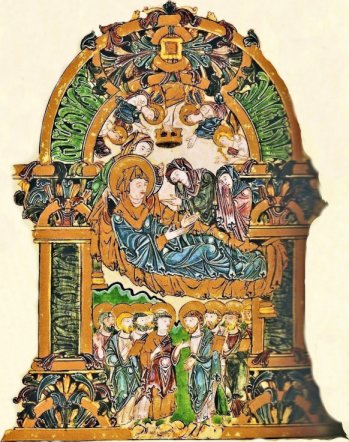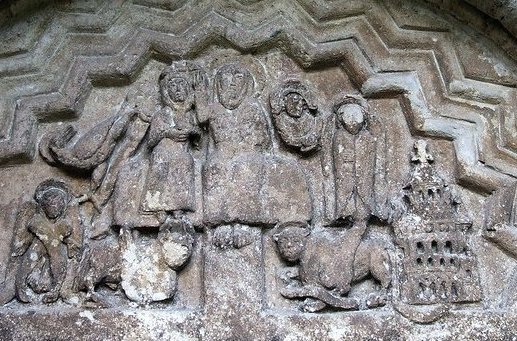|
The Coronation of the Virgin - 2 |
|
|
In The Cult of the Virgin in Anglo-Saxon England Mary Clayton discusses the pre-conquest veneration of the Virgin, in particular at Canterbury and Winchester. In my piece on the Immaculate Conception I mentioned that the earliest record of the celebration of this as a feast day was at Winchester. The image of the Coronation of the Virgin was highly significant in England, and as we will see below some of the very earliest images can be found there. Why should this be? Maybe this image goes some way to providing an answer. |
|
|
|
|
|
To start, below left is a page from The Benedictional of St. Aethelwold, produced in Winchester between 971 and 984, possibly to celebrate the coronation of King Edgar and his Queen in 973. Note the crown being lowered from Heaven by God the Father, helped on its way by angels. On the right is a page from Liber Uitae, also from Winchester c 1030. What is happening here? On the right we see King Cnut (Canute). On the left is his Queen Aelfgifu, more commonly known as Emma. Following Cnut's conquest of England (1015 - 1016) he married Emma, who had been queen to the defeated Aethelred. This page illustrates Cnut and Emma presenting a gold cross to Hyde Abbey, in Winchester. Note the iconography here. One angel is lowering a crown on to the head of Canute, while another lowers the veil of the Virgin on to the head of Emma. Above, the Virgin and St. Peter stand on either side of the enthroned Christ. |
|
|
|
|
|
Clearly this is not a version of the Coronation of the Virgin, but the iconographic parallels are striking. It seems to me that it was only in England that the Coronation of the Queen of Heaven became associated with royal coronations, royal queens. Why? Perhaps because queens were important in England - less so in Italy. Two more images. On the left is a capital from Reading Abbey, in Berkshire. On the right is a tympanum from St. Swithun's Church, Quenington, Gloucestershire. Both show the Virgin being crowned Queen of Heaven. They are the earliest surviving examples of this particular image in existence. |
|
|
|
|
|
Reading Abbey too has royal connections. It was
founded in 1121 by Henry 1st at a difficult moment; his son and heir had
been drowned in the White Ship disaster the previous year. Henry had taken a
new wife, Adeliza of Louvain, in the hope of a new heir. Pauline Stafford,
in Gender, Family and the Legitimation of Power – England from the
Ninth to Early Twelfth century,
(2006) tells us this: The theme of Mary as Queen of Heaven grew in tenth and eleventh century England, at the same time as the power of English queens on Earth was growing. A very early representation of her as queen would have been appropriate at Reading, dedicated to Mary and St John but also founded using previous queen’s lands. The representation of the moment of her coronation, however, is not simply in line with these earlier English developments. It seems to underline the close association of the Reading iconography with its royal founder’s second marriage and the coronation of his wife in January 1121. An association still clear in the minds of those who commissioned work there through the 1120s. What better symbol than the Virgin mother, intercessor par excellence, crowned queen by her son, to bring together all the meanings of 1121: queenship, fertility, purity and penance. Finally, a wall painting - from St Mary's
Church, Black Bourton, Oxfordshire, uncovered from layers of whitewash in
the 1930s. Later than the images above - late 13th century - but it
demonstrates that the image of the Virgin's Coronation remained a powerful
one in England. |
|
|
|
|





